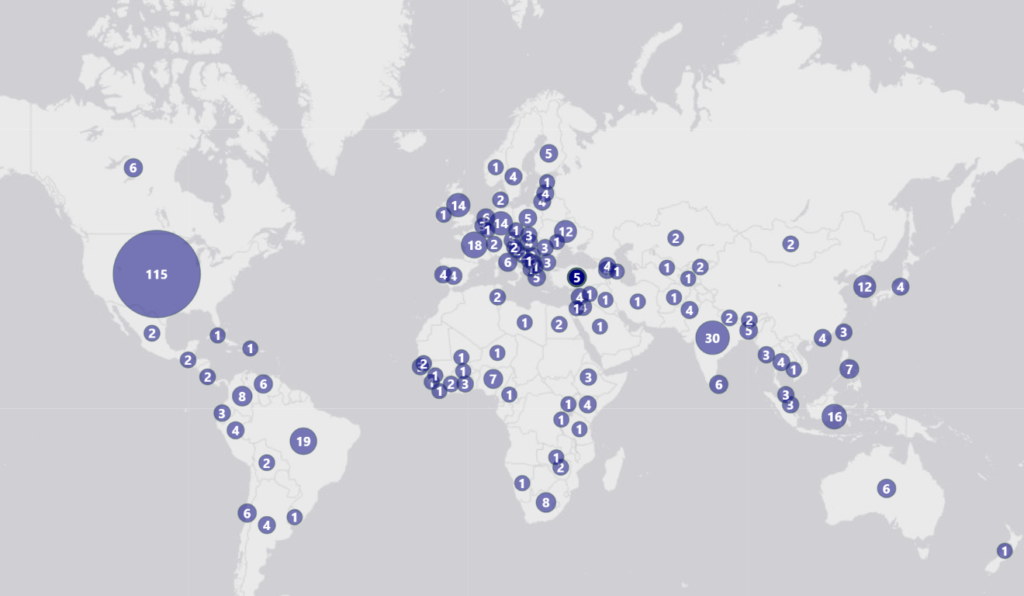
Today, the threat of disinformation is everywhere. Like putting a genie back in the bottle, it is impossible to suppress once it is online.
That’s why adopting proactive digital communications strategies is vital to ensure your organization has the tools to fight disinformation.
In this article, I outline five proven communications strategies to help you fight disinformation online.
While the COVID-19 pandemic exposed our vulnerability to disinformation and the need to react quickly to new events, the advent of artificial intelligence (AI) and deep fakes creates a perfect storm, increasing the speed and availability of malicious tools. Today, recent studies show that over 75% of consumers are concerned about misinformation from AI. However, when it comes to finding out the truth, trust in traditional media is at an all-time low, with the Edelman Trust Barometer 2023 showing that both government and media are increasingly seen as sources of misleading information.
“A shared media environment has given way to echo chambers, making it harder to collaboratively solve problems. Media is not trusted, with especially low trust in social media,” concludes the Edelman Trust Barometer. Such a lack of trust is leading many people to search for independent or alternative sources for information.
“Tackling the various forms of information disorder is now a priority issue for many, including strategic communicators who are looking to build and maintain trust,” said Alexander Buhmann, Associate Professor of Corporate Communication at BI Norwegian Business School, Oslo, Norway in the European Communications Monitor 2023. “As new platforms and AI-driven tools are set to further exacerbate these challenges, the search for ways to achieve purpose-driven and authentic stakeholder engagement will occupy practitioners and researchers alike.”
Meanwhile, digital news consumption is increasingly social, with the latest global research from Reuters showing that 30% of people stay up-to-date on current events using social media. Short-form video platforms like Instagram, YouTube, and TikTok are quickly becoming more important for news.
“When it comes to news, audiences say they pay more attention to celebrities, influencers, and social media personalities than journalists in networks like TikTok, Instagram, and Snapchat,” says the Reuters study.
Research from Reuters shows that 30% of people get their news from social media, with celebrities and influencers gaining authority.
These days, a false statement can quickly spread on social media. Add to this the growing impact of echo chambers, where social media users only see comments and posts from people they follow and agree with, increasing the potential for disinformation to be shared without scrutiny.
“We’re now seeing a boom of trends born from social media,” states the 2023 Social Media Trends Report by Talkwalker, the social listening platform. “Stories that have no real-world origin, but instead come from a TikTok concept, a Twitter hashtag, a Facebook meme, an influencer pick-up, or something else. Once born, trends thrive. When they get big enough, they gather news coverage, which inspires more social coverage, and drives more mentions and awareness. And the trend grows.”
How do you fight disinformation in such a volatile environment? How do you stop fake news in an online forum where social media rewards controversial and polarizing content, helping it go viral?
Welcome to a new world where people increasingly get their information from celebrities and influencers on TikTok or Instagram.
In this blog post, I’m sharing insights and tips on the top five proven digital communication strategies every seasoned leader should consider, complete with real-world examples and case studies to help prevent and fight disinformation.
Welcome to a new world where people increasingly get their information from celebrities and influencers on TikTok or Instagram.
Nicholas Bruneau Tweet
1. Plan Ahead
Review Your Crisis Communications Plan
Prevention is better than cure, and the best way to prevent the harmful effects of disinformation is to be prepared for it.
A crisis communications plan is essential for organizations to effectively manage and respond to unforeseen events that may threaten their reputation, operations, or stakeholders.
The first step is to set up your crisis communications team, including representatives from key departments, such as public relations, legal, cybersecurity, and relevant subject matter experts. Designate a spokesperson or crisis communication plan leader who will be the primary point of contact for media and other stakeholders.
Then, map out potential scenarios and establish clear internal and external communication protocols. Having a procedure in place will help you to respond quickly and efficiently. This includes developing specific communication strategies for each key stakeholder group and crafting pre-approved messages to address a crisis effectively.
2. Collaborate
Strengthen Internal Cross-Functional Collaboration
Your ability to foster collaboration across departments is a formidable asset. The communications team must work closely with experts, regularly attending joint meetings to develop prevention strategies that combine technical, scientific, and political communications.
While at the Global Partnership for Education (GPE), I regularly attended high-level political meetings to anticipate potential threats or issues that might come up in partner countries. This ensured that we were informed and aligned with the ever-changing political landscape.
Another example of successful internal collaboration is the European Commission’s proactive response at the start of the COVID-19 outbreak. To fight disinformation, Tina Zournatzi, former Head of Communications, assembled groups and individuals from various parts of the Commission, experts, and policymakers with a holistic view of the situation. This way, the communications team was able to increase coordination with all the other departments to debunk any misinformation and disinformation quickly.
“We anticipated the challenges of responding to disinformation and coordinated with all the other departments to connect with experts in the field. We brought together teams and individuals from various parts of the Commission, as well as experts and policymakers who had a holistic view of the situation,” said Zournatzi. “In this way, we were able to create new synergies early on to encourage collaboration across departments.”
This united effort helped create new synergies and encourage collaboration across departments. The COVID-19 disinformation monitoring and reporting program set up new tools and services to improve access to reliable information on health issues. The EU launched the disinformation toolbox, helping Europeans distinguish fact from fiction on vaccines, and the European Commission’s communications team became more agile and responsive to a growing number of online disinformation campaigns.
Researchers were joined up and aligned, helping to transform the process of debunking misinformation in an integrated and operational way. This cross-functional approach has resulted in timely threat detection and prevention.
“Today, we can respond, provide answers and publish authoritative information about the latest disinformation topics in a way that is much faster and more effective,” said Zournatzi (read more in my interview with Tina Zournatzi).
We anticipated the challenges of responding to disinformation and coordinated with all the other departments to connect with experts in the field.
Tina Zournatzi Tweet
As part of these efforts to strengthen internal communications, you can also help shape employee advocacy programs to amplify your message across networks.
Employees are often the frontline ambassadors of an organization, making them crucial in the battle against disinformation. Establishing employee advocacy programs can make your staff a powerful force for truth and authenticity by helping them to share accurate information on their personal social media accounts and providing them with training on how to identify and counter disinformation effectively.
WWF Germany’s Expert Ambassador Program is a standout example. They empowered their employees and highlighted their expertise in specific areas, enhancing their brand image and creating a network of high-profile advocates who could counteract false narratives about the company (read more in my interview with Marco Vollmar).
3. Build Trust
Build Trust and Transparent Communication Channels
Building trust is paramount when combating disinformation. Establish transparent communication channels to inform your audience about your organization’s activities, values, and decision-making processes. Openness fosters trust, making it harder for disinformation to take root.
“Constant communication on what the government is doing, managing expectations and then addressing the issues head on are important. The public needs information more than ever”, said Lesley Cordero, Senior Disaster Risk Management Specialist at the World Bank, while speaking at a forum on crisis management. “In the absence of clear credible information, people turn to alternative sources – including fake news.”
Transparency and accountability are essential. Cordero added that communicating with consistency, clarity, and credibility is essential to establish trust and combat disinformation in a crisis. You will build trust with news organizations and influencers by staying true to these values and never cutting corners in your communications.
Constant communication on what the government is doing, managing expectations and then addressing the issues head on are important. The public needs information more than ever
Lesley Cordero Tweet
An example of an organization building trust with media is the EU Drugs Agency. Over the past few years, the agency has seen several requests for fact-checking (due to the challenges of fake news) and requests from data journalists to access the underlying data in its reports. In response to a growing thirst for verified data, the agency has modernized its media communications platform to include informative maps, persuasive infographics, and interactive dashboards, allowing journalists to zoom in on results and shape their stories with open data provided by the agency. This transparency has helped the EU agency build credibility and closer links with data journalists and data journalist networks.
Collaboration with fact-checking organizations should also be part of your communications strategy, helping them to validate and debunk information swiftly. By leveraging their expertise, you can strengthen your organization’s credibility and reassure your audience that you are committed to providing accurate information.
You can find a list of fact-checking organizations by country and Integrity Organization Map, allowing you to proactively contact them to build a relationship that can facilitate quick responses and collaboration.
Meanwhile, it is crucial for you as an organization to have a direct contact or account manager in each social media platform where you are present to ensure that you have a quick way to flag any issues related to your account or organization. We did this while I was working for GPE, which helped minimize technical problems with the Twitter/X account of our CEO.
One example of a proactive initiative is Türkiye’s Center for Fight against Disinformation, which monitors and prevents disinformation efforts. The center seeks to counter psychological warfare, propaganda, perception operations, manipulative content, and domestic and foreign disinformation campaigns. The center issues a weekly “Disinformation Bulletin”, collaborates with public and private sector organizations, and de-bunks fake news that spreads on social media.
“We believe that our citizens are effective defenders of the truth. We are in constant communication with news producers on traditional and social media to access accurate information. By establishing the Center for Combating Disinformation, we offer a source of verification against misleading information,” said Fahrettin Altun, Communications Director for the Government of Türkiye, in a recent article on disinformation.
4. Be Digital-First
Get to Know Your Community Online
Since disinformation spreads fastest online, it makes sense to think digitally when taking a proactive approach against hybrid threats and disinformation.
Communications teams must implement advanced monitoring tools to monitor online conversations related to their organization. This involves tracking mentions on social media, news outlets, and other digital platforms. You need to adopt tools that allow you to monitor your reputation online, measure brand awareness and use advanced analytics to visualize conversation clusters and map out sentiment analysis about your brand and industry.
By employing social listening tools, you can anticipate and respond to false rumors circulating online. This can cement your organization’s credibility in times of need.
“Never before have communication leaders faced such great opportunities and risks at the same time,” said Ansgar Zerfass, Professor and Chair of Strategic Communication at Leipzig University, Germany, in the European Communications Monitor 2023. “CommTech, big data, and services based on artificial intelligence can enhance the efficiency and effectiveness of organisational communication, but they also threaten current business models of communication departments and agencies. Concise transformation strategies adapted to the situation and courageous leadership are necessary to move forward.”
Never before have communication leaders faced such great opportunities and risks at the same time.
Ansgar Zerfass Tweet
Knowing your audience & what they are talking about can give you a distinct advantage, allowing you to connect with your stakeholders and address their concerns. Using tools like Audiense, you can map out your audience, pinpoint who can reach them, and break through echo chambers online.
Being prepared also means having the digital skills and platforms to analyze what is happening online. If you don’t have the skills, explore training opportunities or consider hiring new talent to integrate analytical tools into your communications planning. By adopting these skills, your team can better understand relevant communities online and start participating in discussions on encrypted messaging platforms Signal, Telegram, and WhatsApp, for example.
Addressing people’s concerns directly, speaking their language, and showing compassion are the best ways to help combat negative perceptions or disinformation.
During the pandemic, UNICEF MENARO worked to fight disinformation and strengthen communications with its stakeholders using regular online monitoring. They used listening tools like Talkwalker to understand what people were talking about, monitoring rumors in real time to see how prevalent disinformation was, and which topics needed to be countered.
The World Bank also uses Talkwalker for social listening. Other tools include Brandwatch, YouScan, or Keyhole, allowing you to monitor chatter online, join those conversations directly, and create relevant content.
One example of this approach was the World Food Programme’s participation in online conversations about the humanitarian crisis in Yemen. “We noticed a growing number of posts about Yemen coming out of the Black Lives Matter movement,” said Corinne Woods, former Communications Director of the WFP.
“A number of people engaged in the movement were starting to create their own content about Yemen, and it moved in between Instagram and TikTok. So we started taking part in the growing conversations around Yemen and created classically Gen Z TikTok owner-generated content around it.”
By riding the wave of interest about Yemen, WFP raised awareness about the situation on social networks (read more in my interview with Corinne Woods).
5. Amplify
Deliver Your Message to the Right People at the Right Time
Once they had data on the objections to COVID-19 vaccines and information on the regions most affected, UNICEF MENARO adopted proactive, localized communications strategies on social media led by influencers and community leaders. The #PledgeToPause campaign was created with local community influencers, helping to share the right message with the right people.
“The fight against the infodemic is likely to continue well into the future. We at UNICEF MENARO will continue listening to our audiences of whom we massively care about, and innovatively use all the tools at our disposal to counter the spread of rumors and false information and communicate to people the importance of trusting only credible sources… We also learned that it is significant to be close to people’s hearts to address their concerns and those of their loved ones; using the language of a friend and not that of an instructor,” said Juliette Touma, former Chief of Advocacy & Communications for UNICEF Middle East & North Africa, in the UNICEF case study.
We learned that it is significant to be close to people’s hearts to address their concerns and those of their loved ones; using the language of a friend and not that of an instructor
Juliette Touma Tweet
With storytelling techniques, you can create an engaging story and counter-act what others think and say. Here, you should use short-form videos, local language, or whatever is trending with your audience in the channels where they hang out. By prioritizing short-form video, you can grab people’s attention and encourage shareability.
The World Health Organization (WHO) is adopting short-form vertical videos for TikTok, Instagram Stories, and LinkedIn, featuring quick cuts and catchy comments on critical issues. They regularly create videos to “debunk” myths about health issues.
To increase your impact, you can also explore promoted posts (which will work well if you specifically target the followers of people that are spreading your disinformation) or work with relevant influencers to respond to concerns about your organization.
Find an easy call-to-action that influencers and celebrities can quickly adopt. While at GPE we created an influencer strategy to encourage politicians, community leaders and celebrities to “Raise Their Hand” for education, making it easy for them to participate in the campaign with a photo or short video.
Influencer marketing can be highly successful, but it’s all about finding a balance – where you as an organization are comfortable.
If you implement a monitoring system to track media coverage, social media conversations, and stakeholder reactions during a crisis, you will be in a great position to evaluate and improve your crisis communication plan regularly.
In conclusion, safeguarding against disinformation requires a multifaceted and proactive approach. By staying ahead of the curve, adapting, and refining your crisis communications strategies, your organization will be ready to fight disinformation and meet the ever-evolving challenges posed by the digital landscape.
See my presentation below from the Stratcom Summit 2023 for the panel discussion on “New Dilemmas for Strategic Communications”:
- Written by: Nicholas Bruneau
- Posted on: November 22, 2023
- Tags: Crisis Communications, Disinformation, Social Media


